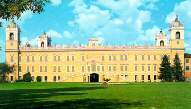



REGGIA DI COLORNO (12 KM da Parma):
info: tel.0521-313336- fax 0521-521370 reggiadicolorno@libero.it
The first Fortress in Colorno was built in the XIII century to protect the region across the Po river. It belonged to noble families such as the Da Correggio and the Terzi family.
From an ancient Fortress to a refined mansion, it reached a great splendour thanks to the cultivated and nice Barbara Sanseverino who, between the XVI and XVII century, made the palace the seat of a refined court life by gathering the paintings of Tiziano, Giulio Romano, Correggio, Mantegna e Raffaello.After the decapitation and the confiscation of the property of the countess on order of the Duke Ranuccio I, in 1612 Colorno and its Fortress passed on to the Farnese family.
About 100 years after Barbara's death the Duke Ranuccio II Farnese started the works which gave the Fortress its current baroc look.Many interventions were planned by the Court architect Ferdinando Galli Bibiena: the Palace, the park and the fountains of Colorno became famous at the other Courts due to their magnificence and beauty.
The Borboni succeded the Farnese. As a matter of fact, in the night of 17 October 1732 the 17-year old Don Carlos, arrived from Spain, entered the ducal park which appeared in its magnificence, brightly lit, animated by players, singers, surprise machines and fireworks.
Since 1750, during the reign of Don Filippo of Borbone the architect Petitot and the sculptor Boudard worked in the palace; the Court Theatre regularly received Italian and French companies which stirred Carlo Goldoni who was often among the guests of the Court.The French revolution and the Napoleone's campains upset the happy court life. The palace was declared "imperial" (that is possible residence of the French emperor)and the Vienna Congress assigned it to the former empress the Austria Grand Duchess Marie Louise.
During her thirty-year excellent governing she took great care both of the park and of the Palace where she often spent her days.
The Borbone succeded her after her death, who where called "the second" to distinguish them from the previous family and with them the Court life ended up.
Nowadays the Palace houses shows and exhibition and the park is open to the pubblic.
